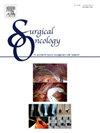A novel technology for margin extension and local control in breast conservation surgery: Saline-coupled intraoperative radiofrequency ablation (SIRA)
IF 2.4
4区 医学
Q3 ONCOLOGY
引用次数: 0
Abstract
Importance
Breast-conserving therapy (BCT) results in reoperation in ∼20 % of cases due to positive margins, and a 7–13 % recurrence risk at 5 years persists despite negative margins and radiation. Enhancing margin treatment is critical to reducing local recurrence and improving survival.
Objective
To optimize and evaluate the performance of a Saline-coupled Intraoperative Radiofrequency Ablation (SIRA) device in producing uniform 1 cm ablations in lumpectomy cavities and compare it to prior-generation RFA technology in previous clinical studies.
Design, setting, and participants
This case series (2018–2023) included 55 mock lumpectomies performed on prophylactic mastectomy or cadaver breasts under an IRB-approved protocol. Inclusion required disease-free, sufficient-volume breast tissue with patient consent.
Results
55 ablations were performed on breasts from 44 female patients. The SIRA produced an ablation depth of 1.0 ± 0.2 cm (mean, SD), no significant difference between margins (p = 0.056). No significant difference in ablation depth across the following: BI-RADS breast composition (p = 0.212), age (p = 0.188), height (p = 0.643), weight (p = 0.522), tissue volume removed (p = 1.000), breast surgery history (p = 0.246), chest chemotherapy/radiation history (p = 0.477), or surgeon (p = 0.579). Significant difference in depth and variance between the SIRA and previous-generation technology (p < 0.001 and p = 0.016), with SIRA significantly deeper and more uniform.
Conclusion
Lumpectomy followed by SIRA could reduce positive margin rates and treat additional tissue, resulting in reduction in re-excision rates and serve as a potential alternative to radiation therapy.
保乳手术中边缘延伸和局部控制的新技术:术中盐偶联射频消融(SIRA)
保乳治疗(BCT)导致约20%的病例因切缘阳性而再次手术,尽管切缘阴性和放疗,5年后仍有7 - 13%的复发风险。加强切缘治疗对于减少局部复发和提高生存率至关重要。目的优化和评估盐耦合术中射频消融(SIRA)装置在乳房肿瘤切除术腔内产生均匀1cm消融的性能,并将其与先前临床研究中的上一代射频消融技术进行比较。设计、环境和参与者本病例系列(2018-2023)包括55例在irb批准的方案下对预防性乳房切除术或尸体乳房进行的模拟肿瘤切除术。纳入需要患者同意的无病、足够体积的乳腺组织。结果44例女性患者共行55例乳房消融手术。SIRA产生的消融深度为1.0±0.2 cm(平均,SD),边缘间无显著差异(p = 0.056)。BI-RADS乳房组成(p = 0.212)、年龄(p = 0.188)、身高(p = 0.643)、体重(p = 0.522)、切除组织体积(p = 1.000)、乳房手术史(p = 0.246)、胸部化疗/放疗史(p = 0.477)、外科医生(p = 0.579)在消融深度方面均无显著差异。SIRA与上一代技术在深度和方差上存在显著差异(p <; 0.001和p = 0.016),其中SIRA明显更深,更均匀。结论乳房肿瘤切除术后SIRA可降低阳性切缘率和治疗额外组织,减少再切除率,是放疗的潜在替代方法。
本文章由计算机程序翻译,如有差异,请以英文原文为准。
求助全文
约1分钟内获得全文
求助全文
来源期刊

Surgical Oncology-Oxford
医学-外科
CiteScore
4.50
自引率
0.00%
发文量
169
审稿时长
38 days
期刊介绍:
Surgical Oncology is a peer reviewed journal publishing review articles that contribute to the advancement of knowledge in surgical oncology and related fields of interest. Articles represent a spectrum of current technology in oncology research as well as those concerning clinical trials, surgical technique, methods of investigation and patient evaluation. Surgical Oncology publishes comprehensive Reviews that examine individual topics in considerable detail, in addition to editorials and commentaries which focus on selected papers. The journal also publishes special issues which explore topics of interest to surgical oncologists in great detail - outlining recent advancements and providing readers with the most up to date information.
 求助内容:
求助内容: 应助结果提醒方式:
应助结果提醒方式:


